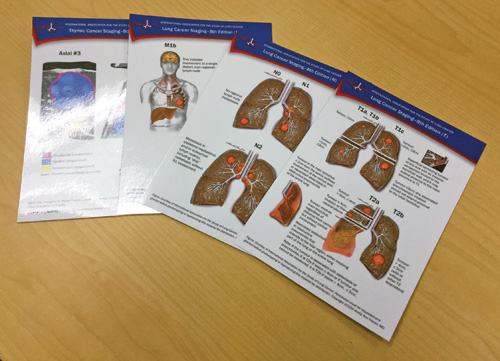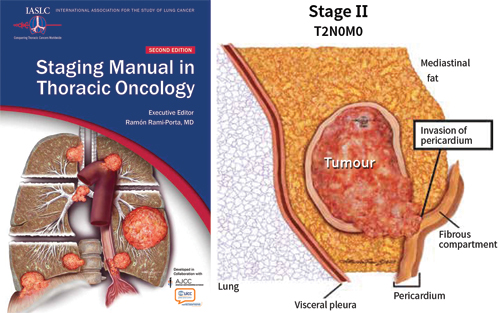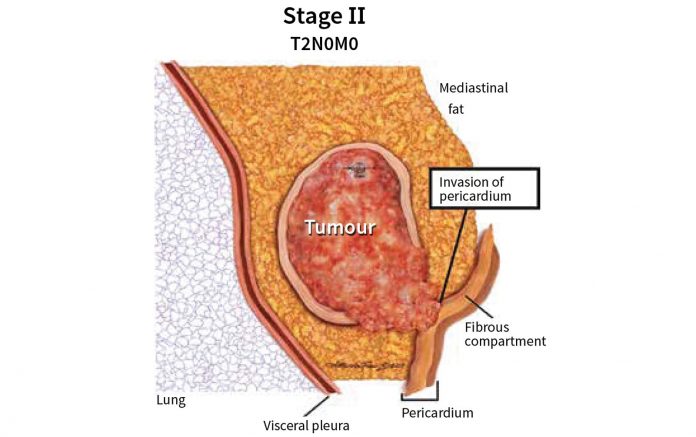By Hisao Asamura, MD, Masaya Yotsukura, MD, and Ramon Rami-Porta, MD, on behalf of the International Association for the Study of Lung Cancer Staging and Prognostic Factors Committee
Posted: June 2018
The IASLC Staging and Prognostic Factors Committee (SPFC) proposed revisions to the lung cancer staging system for the 8th edition of the TNM Classification of Malignant Tumors. The Union for International Cancer Control (UICC) and the American Joint Committee on Cancer (AJCC) accepted these revisions, and the 8th edition of the TNM Classification was implemented in January 2017. In the United States, implementation was delayed until January 2018; now, the new edition has been enacted worldwide.
TNM staging is a tumor classification system that, in principle, reflects the anatomic extent of the tumor based on the extent of the primary tumor (T), the nodal spread (N), and the distant metastases (M). Revisions from the 7th to 8th editions were made to achieve refined prognostic capabilities and to help clinicians stratify tumors based on expected prognosis. All of these changes were based on prognostic analyses of data from the IASLC database—which included 70,697 evaluable patients with NSCLC and 6,189 with small cell lung cancer—and on clinical judgment. T Descriptors In the T component of lung cancer, the T1 category was divided into three subcategories (T1a-T1c) according to 1-cm cutoff points of the greatest dimension. The T2 category now includes tumors larger than 3 cm but no more than 5 cm and was divided into T2a and T2b based on 1-cm cutoff points. Tumors larger than 5 cm but no more than 7 cm were classified as T3, and tumors larger than 7 cm were classified as T4. Adenocarcinoma in situ (Tis(AIS): tumors without a solid part on CT image or a pathologic invasive part) and minimally invasive adenocarcinoma (T1mi: tumors with a solid part of < 0.5 cm on CT image or a pathologic invasive part of < 0.5 cm) were introduced. Sub-solid tumors 3 cm or less in the greatest dimension were recommended to be classified according to the size of the solid part on CT image or the pathologic invasive part. Involvement of main bronchus without carina was categorized as T2 regardless of distance to the carina. Total atelectasis and total obstructive pneumonitis were downgraded from T3 to T2. Invasion of the diaphragm was upgraded from T3 to T4.
| What Is TNM? • The determination of the anatomic extent of the tumor according to three components: Primary tumour (T) Lymph nodes (N) Metastasis (M) • Components have categories: T1a, N3, M1c, etc. • Categories are defined by descriptors: size, location, invasion, etc. |



(Left to Right – Dr. Masaya Yotsukura, Dr. Hisao Asmura, Dr. Ramon Rami-Porta)
N Descriptors
The N component featured no changes. However, analyses of the IASLC database revealed prognostic implications of the number of involved lymph nodes and of involved nodal stations. Exploratory analyses of survival showed that N1a (involvement of a single N1 nodal station) had better prognosis than N1b (involvement of multiple N1 nodal stations). N2a1 (involvement of a single N2 nodal station without N1 involvement) had a similar prognosis to N1b. N2a2 (involvement of a single N2 nodal station with N1 involvement) correlated with a worse prognosis than N2a1 but a better prognosis than N2b (involvement of multiple N2 nodal stations).
M Descriptors
M1 categories were refined based on the number of the extrathoracic metastases. Single extrathoracic metastasis was categorized as M1b, and multiple extrathoracic metastases were categorized as M1c. M1a has not changed from the 7th edition, which included metastasis restricted to the thoracic cavity. Prognosis of M1a and M1b diseases were similar; however, due to the difference of anatomic extension of the tumor, M1a and M1b were categorized as different entities.
Stage Grouping
Based on the T, N, and M categories, stage grouping was determined to achieve best prognostic stratifications. Stage IA was divided into stages IA1, IA2, and IA3, correlating with T1a, T1b, and T1cN0M0 tumors. Only T2aN0M0 and T2bN0M0 tumors were categorized as stage IB and IIA, respectively. T1-T2N1M0 and T3N0M0 tumors were grouped as stage IIB. Stage IIIA included T1-T2N2M0, T3N1M0, and T4N0-N1M0 tumors. Stage IIIB included T1-T2N3M0 and T3-T4N2M0 tumors. Stage IIIC was newly introduced to include T3-T4N3M0 tumors. Stage IV was subcategorized into stage IVA (any T, any N, and M1a or M1b), and stage IVB (any T, any N, and M1c).
Tools and Teaching Aids
For a better understanding of the new classification system, reading the TNM Classification of Malignant Tumors, 8th Edition, is strongly recommended. At least for lung cancer, the contents of the staging system are essentially the same among different publications. The following books have been published and can be used for reference:
• UICC TNM Classification of Malignant Tumors, 8th Edition by the Union for International Cancer Control.1
• AJCC Cancer Staging Manual, 8th Edition by the American Joint Committee on Cancer.2
• Staging Manual in Thoracic Oncology, 2nd Edition by the IASLC.3
- The IASLC Staging Manual in Thoracic Oncology is available in English, Chinese, Japanese, German, Spanish, and Italian as a free mobile application in the Apple iTunes and Google Play stores.
The IASLC has launched several resources intended to extend the understanding of and to be a handy reference for the 8th edition of TNM. These include:
• Staging Handbook in Thoracic Oncology.4
• Staging Laminate Reference Cards, 8th Edition.
• Poster: 8th Edition Lung Cancer TNM Staging Summary.
• Poster: 8th Edition TNM Classification of Lung Non- Mucinous AIS, Minimally Invasive Adenocarcinoma (MIA), and Lepidic Predominant Adenocarcinoma (LPA).
• The IASLC Staging Database T-Component/N-Component/MComponent TNM Stage Slide Catalog, Informative Captions, and Citations.
• The IASLC Lung Cancer Staging Project: Articles regarding the 8th Edition of the TNM Classification for Lung Cancer, Thymic Tumors, and Mesothelioma.

To obtain any of these tools, visit iaslc.org, select the Research & Education tab, and choose Staging from the pulldown list. Protocol information is available there, as well as individual links to the various products and resources under the main link for the IASLC 8th Edition Staging Educational Materials. All of these tools can assist with implementation of the protocol in routine daily care.
The educational materials provided by the IASLC differ in nature and in practical use:
• The Staging Handbook in Thoracic Oncology4 is a pocket-sized book that can be easily carried around for instant availability of the basic TNM information, including the descriptors of the three components of anatomic tumor extent. It also includes an atlas with figures describing the different categories.
• The Staging Laminate Reference Cards, 8th Edition, are the perfect size to be kept in the pockets of a white coat or surgical suit for a quick reference to the different categories of the three components of anatomic extent of lung cancer. These are very popular among those involved with the management of thoracic malignancies.
• The posters of the TNM and of the pathologic details of the newcomers into the TNM system (AIS, MIA, and LPA) are static elements intended to be on the walls of physicians’ offices, radiology reading rooms, and pathology review rooms for a quick reference during clinical discussions and while reviewing reports including the clinical and/or pathologic TNM classification.
• The IASLC Staging Atlas in Thoracic Oncology app allows users to have all the basic TNM information and color figures of the categories at the palm of their hands in a very elegant format. It is not an interactive application, but it provides a quick reference if one does not have the books, laminated cards, or posters accessible.
• The IASLC Slide Catalogue, with captions and citations, is a unique tool provided by the IASLC. It is intended to facilitate the understanding and dissemination of the TNM classification in the most accurate way. The slides contain IASLC material extracted from the original articles that informed the changes implemented for the 8th edition of the TNM classification. They are offered to help in the preparation of educational presentations.
• The Protocol is also available, and it is a fundamental tool for those who intend to apply for grants to enable their contribution to the IASLC Staging Projects. This document includes a detailed description of the project, formatted in such a way that allows the text to be copied and pasted into grant forms. This tool has been underutilized in the previous editions.
• Finally, the IASLC Staging Articles contain the science behind the revisions introduced in the 8th edition of the TNM classification. These articles provide all of the data used for the revision, the methodologies applied, the results of the numerous analyses and their interpretation. Any questions that one may have reading the core information included in the laminates, posters, and apps can be resolved by reading these landmark papers. ✦

About the Authors: Dr. Asamura is with the Division of Thoracic Surgery, Keio University School of Medicine, Tokyo, Japan. Dr. Yotsukura is with the Division of Thoracic Surgery, Keio University School of Medicine, Tokyo, Japan. Dr. Rami-Porta is with Thoracic Surgery Service, Hospital Universitari Mútua Terrassa, and Network of Centers of Biomedical Research in Respiratory Diseases (CIBERES), Lung Cancer Group, Terrassa, Spain.
Editor’s Note
 The new 8th edition of the TNM staging system for NSCLC remains highly challenging. Having a tool to help navigate the path to accurate staging is essential. Virtually all our treatment decisions hinge on proper, readily reproducible staging, so it is crucial that staging be done correctly. This goal requires the mutual engagement of pathology, radiology, and all disciplines of oncology. –Corey Langer, MD, Editor
The new 8th edition of the TNM staging system for NSCLC remains highly challenging. Having a tool to help navigate the path to accurate staging is essential. Virtually all our treatment decisions hinge on proper, readily reproducible staging, so it is crucial that staging be done correctly. This goal requires the mutual engagement of pathology, radiology, and all disciplines of oncology. –Corey Langer, MD, Editor
References:
1. Union for International Cancer Control. Briely JD, Gospodarowicz MK, Wittekind CH, eds. TNM Classification of Malignant Tumors, 8th ed. Oxford UK and Hoboken, NJ: John Wiley; 2017
2. American Joint Committee on Cancer. Amin MB ed. AJCC Cancer Staging Manual, 8th ed. Springer; 2017.
3. International Association for the Study of Lung Cancer. Rami-Porta R, ed. Staging Manual in Thoracic Oncology, 2nd Ed. North Fort Myers: Editorial Rx Press; 2016.
4. International Association for the Study of Lung Cancer. Rami-Porta R, ed. Staging Handbook in Thoracic Oncology, 2nd Ed. North Fort Myers: Editorial Rx Press; 2016.











